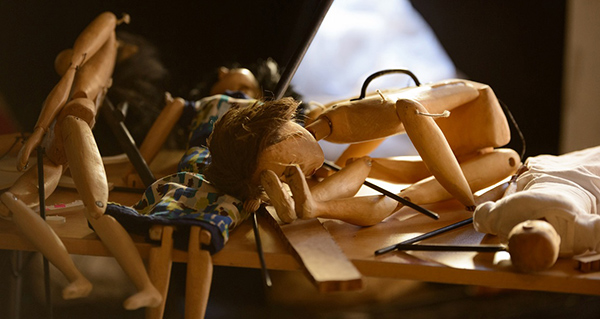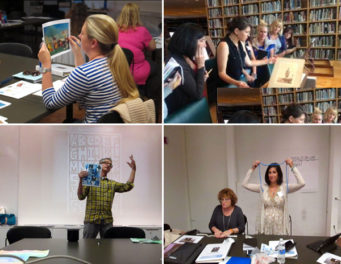
Close-up of Cora, the ancient goddess Persephone reimagined for the 21st century in puppet form. All photos in this post: Colbert Davis
My first exposure to puppetry as a child of the ‘80s was the magic kingdom in Mr. Roger’s Neighborhood. Looking back, I realize my childhood imagination didn’t identify it as puppetry at all. Instead, I was fully taken by the world that had been created for me. I recognized the king, queen, and others as small living beings, and imagined what it would be like if I could fall into their universe. It didn’t occur to me that an actual person might be just below the surface- manipulating inanimate objects—until I learned how to make sock puppets in grade school.
As an adult, the first time the power of puppetry really landed for me was in 2007, at the Under the Radar Festival in New York. I saw Famous Puppet Death Scenes (by the Old Trout Puppet Workshop of Canada) almost by mistake. I was expecting a farce of some kind. One puppet stood on stage, and promised to cure my fear of death. The performance was witty and funny. And it was amazingly beautiful.
In order to make good on his promise, the puppet offered to provide a demonstration of death itself. He offered to die in front of us. When the moment came, I couldn’t breathe. As the puppeteer behind the curtain lifted his hands from the puppet’s body, I realized there truly was no life left in my new friend. I watched a life end, and sat in the theater crying.
In my lifetime so far, I have recognized puppets as magical beings, then as toys to be manipulated, and now as objects that can take on life and breath—or lose it. Puppets can perform in a way that is impossible for humans. They can escape gravity, take on superhero-like powers, and even die (really) on stage.
Working with Janie Geiser and Erik Ehn on Tungsten (artery), being performed this weekend as part of Villa Theater Lab, has been eye-opening. After working with Janie for a few years now, I feel a responsibility not only to the humans working on the project, but also to the puppets themselves. They are transformative, and will have life breathed into them in front of our eyes.

Undressed puppets at the first rehearsal

Puppeteers Molly Allis and Alexis Macnab in rehearsal

Bringing Cora alive
At the first rehearsal of the year we started as most theater projects do, with a reading of the script. But then, just after we introduced all collaborators to one another, the puppets were introduced. Those more skilled in manipulating the puppets gave a brief demonstration, enabling the puppet of Cora (the main character) to walk around the room. Not long after, our voice actors had their hands on the objects. We breathe life into the puppets, but they breathe life into us. While watching two of our actors interact with the puppets for the first time, I noticed their entire posture and face lifting. By concentrating on the life of the puppet, and the life of the other, we are able to temporarily forget our own struggles.

Jenny Greer, the voice of Cora
Tungsten (artery) follows the story of Cora, a modern Persephone, as she travels to and from the underworld. Janie’s puppetry and video, in concert with Erik’s text, makes this cyclical journey more poetic and more visceral than I could have imagined otherwise in live performance. Janie’s program notes explain why:
With Tungsten (artery), we are interested in the emotional power of inanimate objects to illuminate what it is to be human. Puppets move freely between life and non-life—as Cora does…. Puppets are real. They are tangible (wood, paint). They suggest life, but their breath comes from elsewhere: from the voices of the actors, the choreography of the puppeteers, the constructed aural world. They exist in this ephemeral, artificial place, imagined as a shifting volume, as installation, as catalyst, as space of light and moving image, where actions struggle to manifest and disappear, and where intentions broadcast and hide. Word and image work in tandem, fall out of step, scrape against each other. Meaning is constructed through association; truth is elusive, and the questions are between the layers.
I look forward to the next phase of this project’s journey, learning what we can from our time in residence at the Getty Villa, and following Cora through a few more cycles.
_______
Tungsten (artery) is performed Friday–Sunday, February 20–22 at the Getty Villa. Tickets are $7 and are available here.




I love puppets! Thanks for putting into words the way I feel about them, and in fact more so. Sadly, it seems like most people don’t take them seriously, but the ways you describe them show how much they are in fact transcendent to the human experience. I am really looking forward to the performance!
I’ve seen Shakespeare’s The Tempest on stage in various excellent classic and neo interpretations but the one that has stuck with me as the most wonderful and powerful was a puppet performance at the 18th Street Arts Center (Santa Monica) many years ago. Yes indeed, a puppet (itself an art complex!?) can perform a magic that an actor alone cannot.